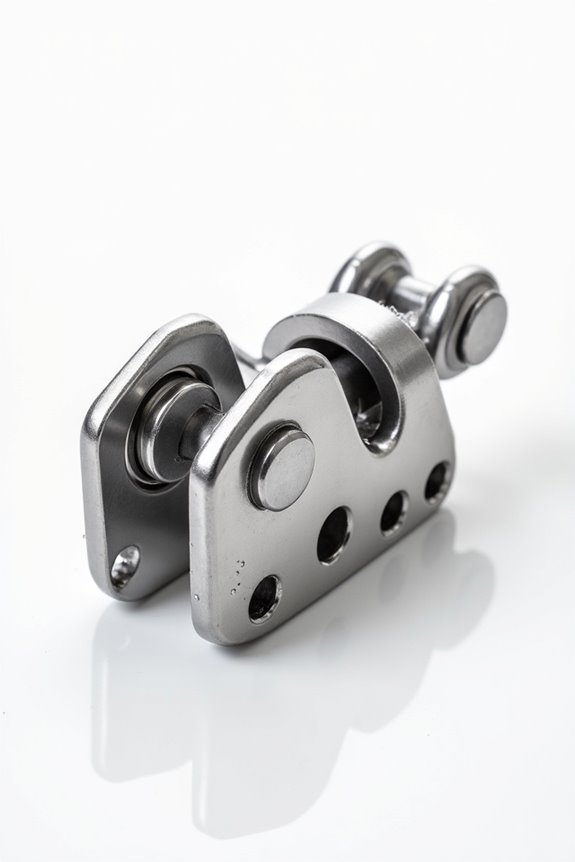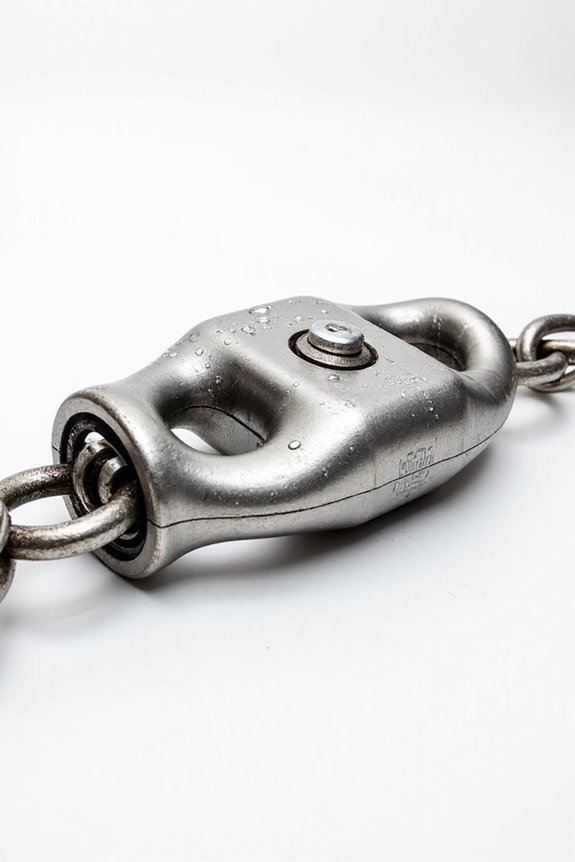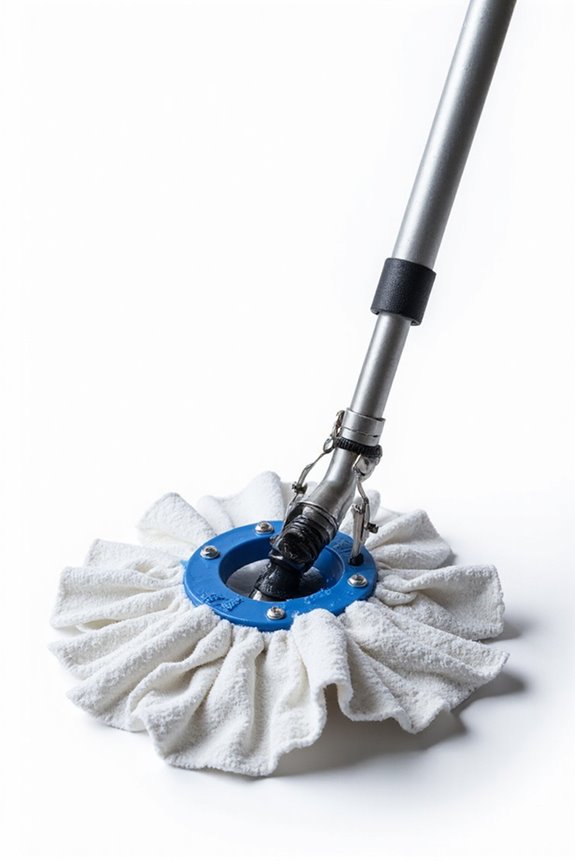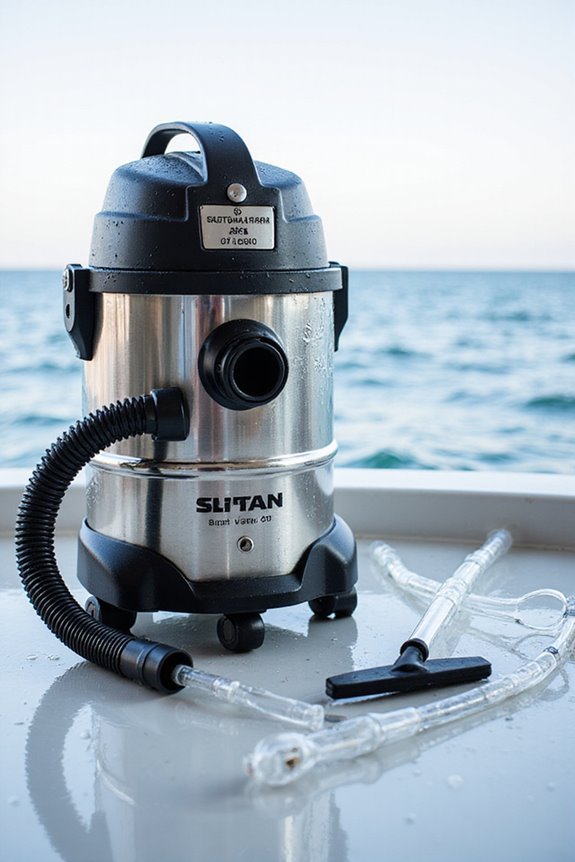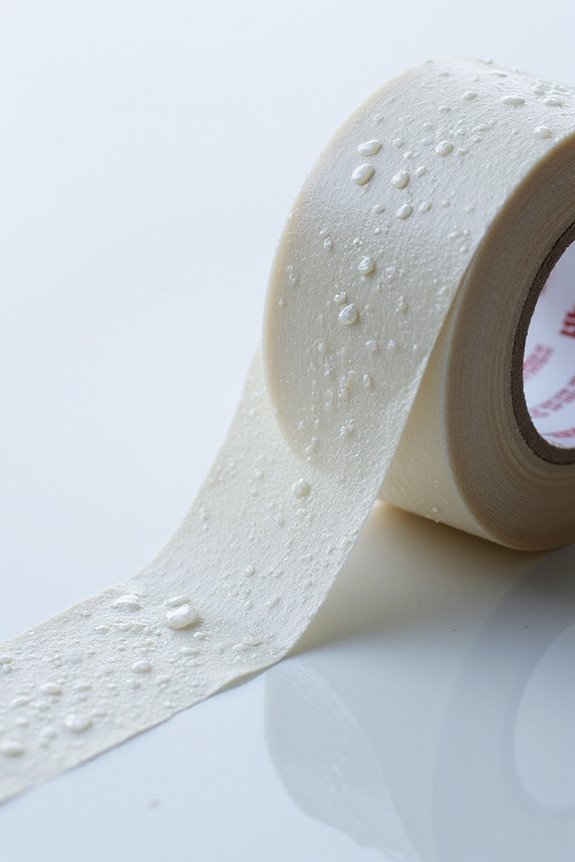When it comes to boat cleats, choosing marine-grade 316 stainless steel means you’re investing in serious durability. This material resists rust and corrosion thanks to its chromium and molybdenum content, making it ideal for saltwater. Plus, it’s way stronger than aluminum or zinc, so it can handle heavy mooring loads without fuss. Sure, it costs more upfront, but it’ll save you from constant replacements. Curious about getting the perfect size or install tips? Let’s explore further.
Key Takeaways
- Marine-grade 316 stainless steel cleats offer superior corrosion resistance, especially in salty or harsh marine environments.
- Stainless steel cleats provide roughly double the tensile strength compared to aluminum or zinc alternatives, ensuring reliable mooring.
- Properly sized stainless steel cleats prevent weak mooring and optimize deck space, enhancing both function and appearance.
- Secure installation with marine-grade caulk and stainless steel bolts ensures long-lasting, waterproof cleat mounting.
- Though initially pricier, stainless steel cleats deliver long-term durability, reducing maintenance and replacement costs over time.
Benefits of Marine-Grade Stainless Steel
While we might think all stainless steel is pretty much the same, marine-grade stainless steel—like the popular 316 type—really stands out when it comes to boat cleats. Ever wonder why? It’s all about the molybdenum advantages: this element considerably boosts corrosion resistance, especially against harsh seawater and salty spray. Plus, nickel’s importance can’t be overlooked—it not only helps the steel resist rust but also keeps it ductile, so it won’t snap under pressure. Together with a strong chromium oxide layer, these metals create a tough, resilient cleat that handles the marine environment like a champ. Additionally, 316 stainless steel provides maximum protection against rust, making it essential for maintaining cleat integrity over time. So, when we invest in marine-grade stainless steel, we’re really gearing up for durability and peace of mind on the water. Pretty smart, right?
Comparing Strength and Corrosion Resistance
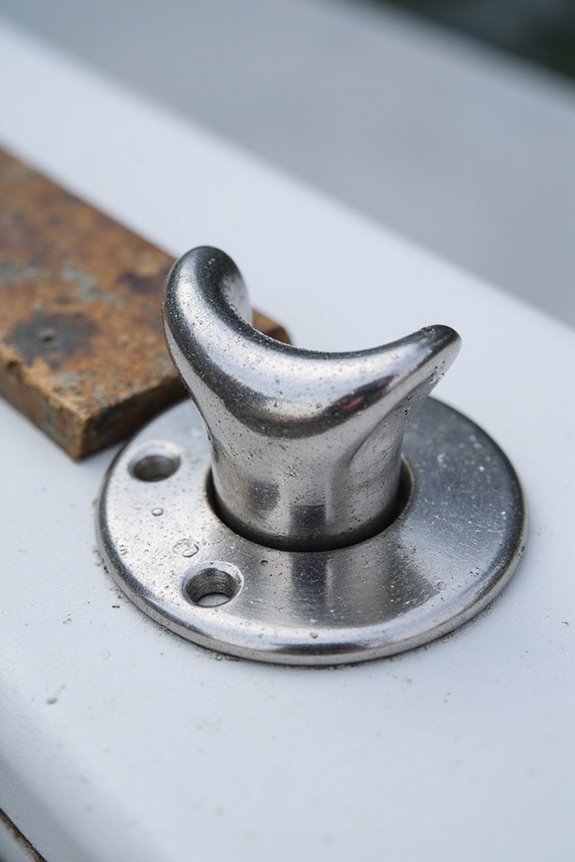
Even though choosing boat cleats might not seem like rocket science, comparing their strength and corrosion resistance is key to making a smart pick. When we talk strength comparison, stainless steel cleats take the crown—offering roughly double the tensile strength of aluminum or zinc. That’s why they handle heavy mooring loads so well. But strength isn’t the whole story; corrosion factors matter too. Grade 316 stainless steel resists rust in both saltwater and freshwater, outlasting many other materials without the pesky galvanic corrosion issues. So, while stainless steel cleats may cost more, their durability and long-lasting shine make them a solid investment. Wouldn’t you prefer cleats that don’t just look tough but stay tough? We sure do.
Design and Size Considerations for Cleats
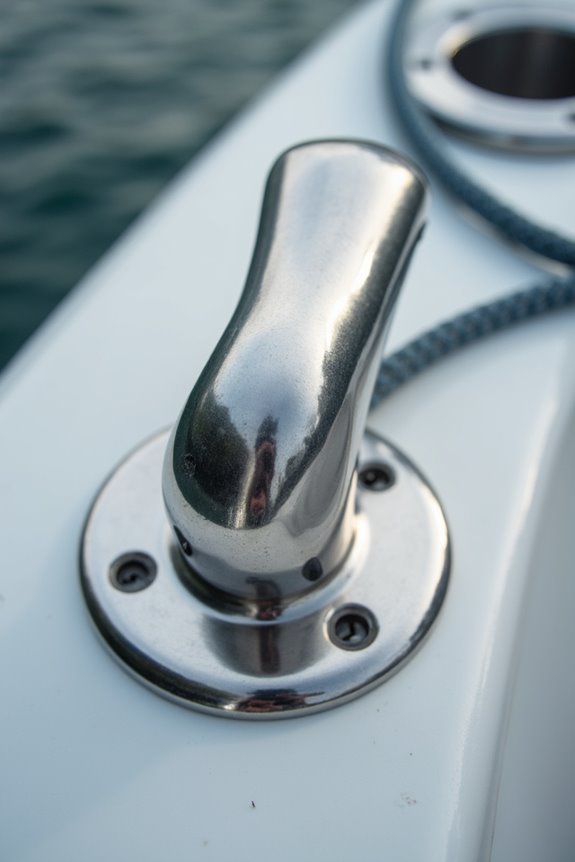
Now that we’ve seen why stainless steel cleats stand out in strength and corrosion resistance, it’s time to talk about how their design and size matter just as much when fitting them to your boat. Choosing the right cleat isn’t just about function—it’s about cleat aesthetics, too. A polished stainless steel cleat can enhance your deck’s look while blending in perfectly through thoughtful cleat integration. Size really counts: for boats under 20 feet, 4 to 6-inch cleats usually do the trick, matching rope diameter at about one inch per 1/16 inch of rope. Too small, and you risk weak mooring; too big, and you’re wasting deck space. So, picking the right size and style means your cleat looks good, works well, and fits your boat like it was made just for her.
Installation Tips for Secure Mounting
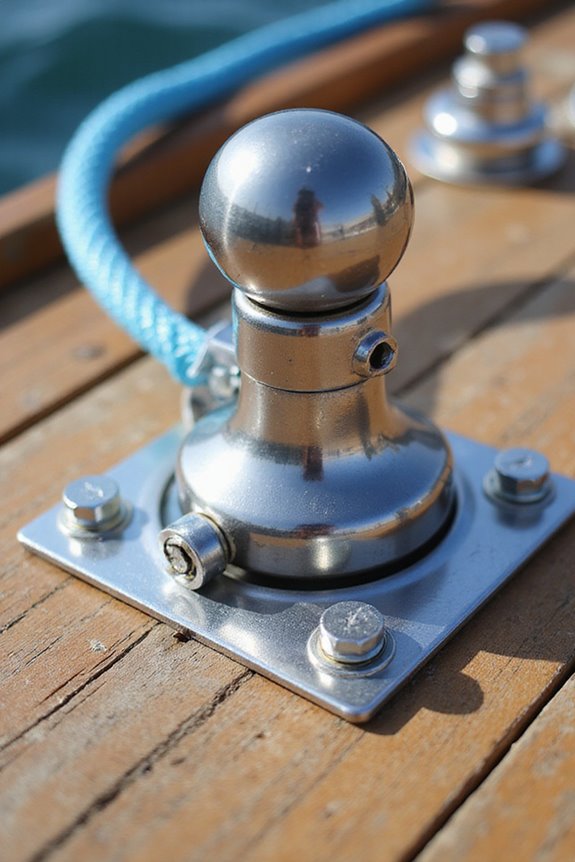
Before we get our hands dirty installing those gleaming stainless steel cleats, let’s talk about setting the stage right—because a strong, secure mount isn’t just luck; it’s good planning. Pre installation planning is key: pick a spot that’s easy to reach but won’t trip anyone up, and make sure you can access the backside for fitting backing plates and hardware. When it comes to sealant application, don’t skip the marine-grade caulk—apply it both under the cleat and on the backing plate to keep water out and strength in. Drill pilot holes to avoid slips, use stainless steel bolts with lock washers, and tighten bolts just until sealant oozes for a perfect seal. Remember, using 316 stainless steel for your cleats will enhance their durability and resistance to corrosion. Ready to make your boat safer and smarter? Let’s get cracking!
Cost Efficiency and Long-Term Value
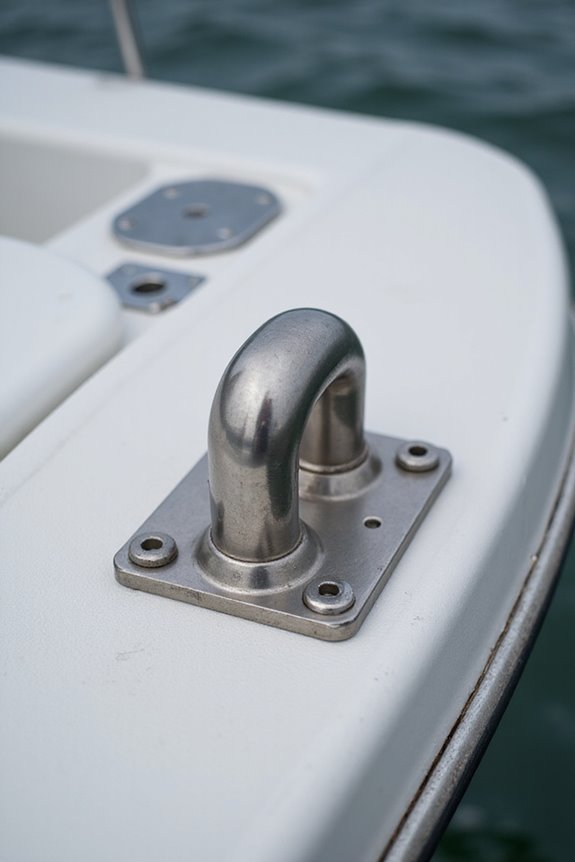
While choosing boat cleats might seem like an easy call, looking closely at cost efficiency and long-term value can save us from future headaches—and wallet aches. Stainless steel cleats may cost a bit more upfront, but they dramatically lower replacement frequency thanks to their superior durability and corrosion resistance. Think about how often you want to fuss with cleat maintenance; wouldn’t you rather spend time enjoying your boat than fixing worn-out parts? Compared to aluminum or nylon, stainless steel stands strong under heavy loads and harsh conditions, making it a smart investment. Its long service life and reduced upkeep not only save money but offer peace of mind. So, why settle for less when a little extra now pays off big down the line?
Frequently Asked Questions
Can Stainless Steel Cleats Be Polished at Home to Maintain Shine?
We can polish stainless steel cleats at home using safe polishing techniques and avoid abrasive tools. While some home remedies exist, specialized polishes work best to maintain shine and protect our cleats from corrosion together.
Are Stainless Steel Cleats Compatible With All Boat Decking Materials?
It is understood that decking material compatibility matters a lot, so stainless steel cleats fit most surfaces well. Just remember cleat installation tips—like reinforcing soft decks and using proper bolts—to guarantee a secure, lasting fit we all rely on.
How Do Temperature Changes Affect Stainless Steel Cleat Performance?
We’re pretty sure stainless steel cleats could survive the surface of the sun! Thermal expansion with heat and slight contraction in cold weather mean we all need to monitor tightness together for lasting, reliable performance.
What Maintenance Is Needed for Stainless Steel Cleats in Freshwater Environments?
It is understood freshwater can still leave deposits, so let’s keep our cleats pristine with gentle cleaning techniques and soft cloths. Applying protective coatings helps maintain the chromium oxide layer, so together, we protect our gear and stay connected.
Are There Eco-Friendly Stainless Steel Cleat Manufacturing Options Available?
Yes, we can find manufacturers using sustainable materials and eco certifications to guarantee eco-friendly stainless steel cleats. By choosing these options, we join a community committed to protecting marine environments while enjoying durable, responsible boating hardware.

